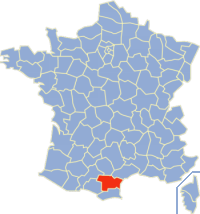|
Armissan
Armissan (; oc, Armissan) is a commune in the Aude department in the Occitanie region of southern France. The inhabitants of the commune are known as ''Armissannais'' or ''Armissannaises'' Geography Armissan is part of the urban area of Narbonne and is located just 2 km east of the city immediately south of Vinassan and inside the Regional Natural Park of Narbonne. Access to the commune is by road D68 from Narbonne passing through the town and continuing south-east to join the D168 to Narbonne-Plage at the southern border of the commune. The D168 from Narbonne to Narbonne-Plage also passes through the south of the commune. There is also the D31 going south from Vinasson through the west of the commune to join the D32. The A9 autoroute passes through the west of the commune but has no exit - the nearest exit is Exit 37 at Narbonne. The commune has large forests in the south-west and in the north with the rest of the commune farmland. The ''Ruisseau Mayral'' with many tr ... [...More Info...] [...Related Items...] OR: [Wikipedia] [Google] [Baidu] |
Le Grand Narbonne
Le Grand Narbonne is the ''communauté d'agglomération'', an intercommunal structure, centred on the city of Narbonne. It is located in the Aude department, in the Occitanie region, southern France. It was created in December 2002. Its seat is in Narbonne.Fiche signalétique CA Le Grand Narbonne BANATIC Its area is 846.6 km2. Its population was 129,134 in 2017, of which 54,700 in Narbonne proper.Comparateur de territoire [...More Info...] [...Related Items...] OR: [Wikipedia] [Google] [Baidu] |
Communes Of The Aude Department
The following is a list of the 433 communes of the Aude department of France. The communes cooperate in the following intercommunalities (as of 2020):BANATIC Périmètre des EPCI à fiscalité propre. Accessed 3 July 2020. * *Communauté d'agglomération Le * [...More Info...] [...Related Items...] OR: [Wikipedia] [Google] [Baidu] |
Communes Of France
The () is a level of administrative division in the French Republic. French are analogous to civil townships and incorporated municipalities in the United States and Canada, ' in Germany, ' in Italy, or ' in Spain. The United Kingdom's equivalent are civil parishes, although some areas, particularly urban areas, are unparished. are based on historical geographic communities or villages and are vested with significant powers to manage the populations and land of the geographic area covered. The are the fourth-level administrative divisions of France. vary widely in size and area, from large sprawling cities with millions of inhabitants like Paris, to small hamlets with only a handful of inhabitants. typically are based on pre-existing villages and facilitate local governance. All have names, but not all named geographic areas or groups of people residing together are ( or ), the difference residing in the lack of administrative powers. Except for the municipal arrondi ... [...More Info...] [...Related Items...] OR: [Wikipedia] [Google] [Baidu] |
Institut Géographique National
An institute is an organisational body created for a certain purpose. They are often research organisations (research institutes) created to do research on specific topics, or can also be a professional body. In some countries, institutes can be part of a university or other institutions of higher education, either as a group of departments or an autonomous educational institution without a traditional university status such as a "university institute" (see Institute of Technology). In some countries, such as South Korea and India, private schools are sometimes referred to as institutes, and in Spain, secondary schools are referred to as institutes. Historically, in some countries institutes were educational units imparting vocational training and often incorporating libraries, also known as mechanics' institutes. The word "institute" comes from a Latin word ''institutum'' meaning "facility" or "habit"; from ''instituere'' meaning "build", "create", "raise" or "educate". ... [...More Info...] [...Related Items...] OR: [Wikipedia] [Google] [Baidu] |
Reliquary
A reliquary (also referred to as a ''shrine'', by the French term ''châsse'', and historically including ''wikt:phylactery, phylacteries'') is a container for relics. A portable reliquary may be called a ''fereter'', and a chapel in which it is housed a ''feretory''. Relics may be the purported or actual physical remains of saints, such as bones, pieces of clothing, or some object associated with saints or other religious figures. The authenticity of any given relic is often a matter of debate; it is for that reason, some churches require documentation of the relic's provenance. Relics have long been important to Buddhism, Buddhists, Christianity, Christians, Hinduism, Hindus and to followers of many other religions. In these cultures, reliquaries are often presented in shrines, churches, or temples to which the faithful make pilgrimages in order to gain blessings. The term is sometimes used loosely of containers for the body parts of non-religious figures; in particular the ... [...More Info...] [...Related Items...] OR: [Wikipedia] [Google] [Baidu] |
Ciborium (container)
A ciborium (plural ciboria; Medieval Latin ''ciborium'' (drinking cup), from the Ancient Greek κιβώριον ''kibōrion'', a type of drinking-cupOED.) is a vessel, normally in metal. It was originally a particular shape of drinking cup in Ancient Greece and Rome, but the word later came to refer to a large covered cup designed to hold hosts for, and after, the Eucharist, thus the counterpart (for the bread) of the chalice (for the wine). The word is also used for a large canopy over the altar of a church, which was a common feature of Early Medieval church architecture, now relatively rare. History The ancient Greek word referred to the cup-shaped seed vessel of the Egyptian water-lily '' nelumbium speciosum'' and came to describe a drinking cup made from that seed casing, or in a similar shape. These vessels were particularly common in ancient Egypt and the Greek East. The word "'ciborium'" was also used in classical Latin to describe such cups, although the only example ... [...More Info...] [...Related Items...] OR: [Wikipedia] [Google] [Baidu] |
Middle Ages
In the history of Europe, the Middle Ages or medieval period lasted approximately from the late 5th to the late 15th centuries, similar to the post-classical period of global history. It began with the fall of the Western Roman Empire and transitioned into the Renaissance and the Age of Discovery. The Middle Ages is the middle period of the three traditional divisions of Western history: classical antiquity, the medieval period, and the modern period. The medieval period is itself subdivided into the Early, High, and Late Middle Ages. Population decline, counterurbanisation, the collapse of centralized authority, invasions, and mass migrations of tribes, which had begun in late antiquity, continued into the Early Middle Ages. The large-scale movements of the Migration Period, including various Germanic peoples, formed new kingdoms in what remained of the Western Roman Empire. In the 7th century, North Africa and the Middle East—most recently part of the Eastern Ro ... [...More Info...] [...Related Items...] OR: [Wikipedia] [Google] [Baidu] |
Narbonne-Plage
Narbonne plage is a resort on the southern (Mediterranean) coast of France in the Aude department. It is separated from the city of Narbonne by the limestone massif ''Montagne de la Clape Montagne or Montagné may refer to: People * Camille Montagne (1784–1866), French military physician and botanist. The standard author abbreviation Mont. (of Montagne) is used to indicate this individual as the author when citing a botanical n ...'' and lies at its foot. The town is heavily dependent upon the tourist trade. The beach currently holds blue flag status, an award it has held on multiple occasions. References External linkstourist office on archive.org {{Coord, 43, 9, 39, N, 3, 10, 1, E, type:city_region:FR, display=title Geograp ... [...More Info...] [...Related Items...] OR: [Wikipedia] [Google] [Baidu] |
A9 Autoroute
The A9 autoroute (La ''Languedocienne''/''La Catalane'') is a motorway in southern France. The road forms part of the European route E15, as does the A9 road (Scotland). The road runs between Orange and Perthus, in the Pyrénées-Orientales at the frontier with Spain where it becomes the ''Autopista AP-7''. The route passes the following major towns and cities Perpignan ( Pyrénées-Orientales), Narbonne ( Aude), Béziers and Montpellier (Hérault), Nîmes ( Gard) and Orange (Vaucluse) before joining the A7 autoroute (Marseille to Lyon). The route is 2x3 as far south as exit 41 (Perpignan-Nord); widening between exit 41 and the Spanish frontier is currently (2012) in progress. The A9 autoroute was operated by the Autoroutes du Sud de la France (ASF), taken over in 2006 by Vinci Autoroutes. The cost of travelling the whole road through the Languedoc-Roussillon region in a car is 23.70 euros (from 1 February 2012).ASFTarifs applicable au 1er février Montpellier Aroun ... [...More Info...] [...Related Items...] OR: [Wikipedia] [Google] [Baidu] |
Vinassan
Vinassan (; oc, Vinaçan) is a commune in the Aude department in southern France. Population See also *Communes of the Aude department The following is a list of the 433 communes of the Aude department of France. The communes cooperate in the following intercommunalities (as of 2020):Communes of Aude Aude communes articles needing translation from French Wikipedia {{Aude-geo-stub ... [...More Info...] [...Related Items...] OR: [Wikipedia] [Google] [Baidu] |
Narbonne
Narbonne (, also , ; oc, Narbona ; la, Narbo ; Late Latin:) is a commune in France, commune in Southern France in the Occitania (administrative region), Occitanie Regions of France, region. It lies from Paris in the Aude Departments of France, department, of which it is a Subprefectures in France, sub-prefecture. It is located about from the shores of the Mediterranean Sea and was historically a prosperous port. From the 14th century it declined following a change in the course of the river Aude (river), Aude. It is marginally the largest commune in Aude. But the capital of the Aude department is the smaller commune of Carcassonne. Geography Narbonne is linked to the nearby Canal du Midi and the river Aude (river), Aude by the Canal de la Robine, which runs through the centre of town. It is very close to the A9 motorway, which connects Montpellier and Nîmes to Perpignan and, across the border, to Barcelona in Spain. There is also a recently renovated train station which se ... [...More Info...] [...Related Items...] OR: [Wikipedia] [Google] [Baidu] |





